Japan
Wood Products Prices
Dollar Exchange Rates of 25th
Apr
2023
Japan Yen 132.40
Reports From Japan
Bank of Japan to review ultra-low
interest rate policy
The decision by the Bank of Japan (BoJ) to maintain ultra-low
interest rates under its new Governor Kazuo Ueda was widely expected,
however, it was the statement from the BoJ that core consumer prices are
likely to rise further that had an immediate impact on the exchange rate
with the yen dropping to a seven-week low against the US dollar at the end
of April.
The statement from the BoJ said it will spend about 12 to 18 months to
review its monetary policy.
See:
https://mainichi.jp/english/articles/20230428/p2g/00m/0bu/040000c
Covid downgraded
All COVID-19 border control measures will be removed on 8 May and
the legal classification of the coronavirus will be downgraded to become the
same as seasonal flu. Incoming travelers will no longer be required to show
proof that they have been vaccinated.
This will encourage a resumption of business travel and should boost inbound
tourism which is an important element in Japan's economy.
However, warnings have been given that there is a risk that a "ninth wave"
of infections is possible because of a recent rise in cases of a new,
contagious, sub-variant of the virus.
See:
https://english.kyodonews.net/news/2023/04/99539cd54a0f-japan-eyes-shift-to-quality-experiences-as-inbound-tourism-recovers.html
Fast up-tick of consumer price index
Consumer prices in fiscal 2022 rose 3% from the previous year, the
fastest gain in 41 years and the consumer price index, which excludes fresh
food prices, stood at 103 in fiscal 2022 (2020+100). The pace of increase
was the fastest since 1981.
Private consumption improving but spending on durable goods weak
The April economic report from the Cabinet Office says “the economy
is picking up moderately, although some weaknesses are seen.” The report
said private consumption is improving but spending on durable goods remains
weak. Most of the rise in spending in April was on services. As a result of
the recent increases in wages and the lifting of covid rules social and
economic activities have picked up.
The April report revised up the assessment on imports for the first time
since July 2022, saying the sector is basically flat. The March report said
imports were “in a weak tone”.
Once again the report referred to slowing foreign economies because of
rising interest rates and financial market fluctuations as risks for the
Japanese economy.
See:
https://japannews.yomiuri.co.jp/business/economy/20230426-105752/
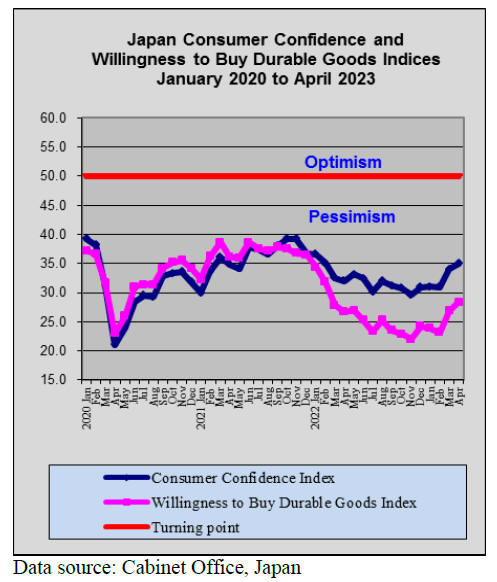
Prices continued to increase in the first quarter of
2023, however, the government programme to support electricity and gas
prices helped slow the rise in the price index. The new Bank of Japan (BoJ)
Governor, Kazuo Ueda, said Japan's consumer inflation is likely nearing its
peak and any further rise will be small.
See:
https://japannews.yomiuri.co.jp/business/economy/20230421-104970/
Long-term employment of foreign workers
It has been reported that the government plans to expand number of
sectors in its programme that allows foreign workers with specific skills to
live in the country long term. The change will mean that the accommodation,
agriculture and food service industries will be included. The plan is aimed
at promoting long-term employment of foreign workers to help resolve worker
shortages.
See:https://www.japantimes.co.jp/news/2023/04/24/national/foreign-workers-program-planned-expansion
Yen weakens
Over the past weeks the yen/dollar exchange rate remained rather
stable as inflation data was at forecast levels however, the suggestion from
the BoJ that inflation will continue to rise for some time drove down the
yen .

Investment in real estate slows
Over the past 12 months the inflow of money from international
investors helped drive up Japanese property values. This has helped drive up
land prices which, according to the Ministry of Land, Infrastructure and
Transport, have risen at the fastest rate in 15 years with the main cities
seeing most of the gains. However, recently the inflow of off shore funds
has slowed.
See:
https://asia.nikkei.com/Business/Markets/Property/Japan-real-estate-sees-signs-of-global-investors-shying-away
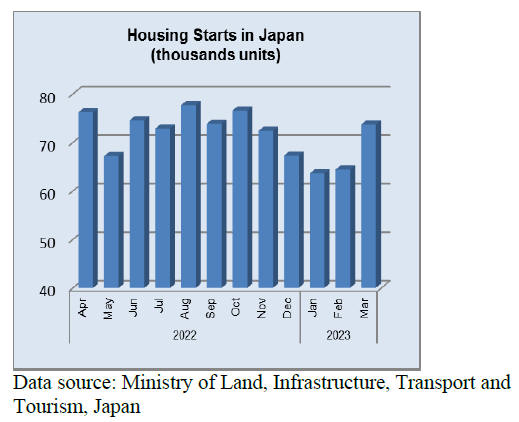
Import update
Massive correction in value of wooden bedroom furniture and wooden
furniture parts imports.
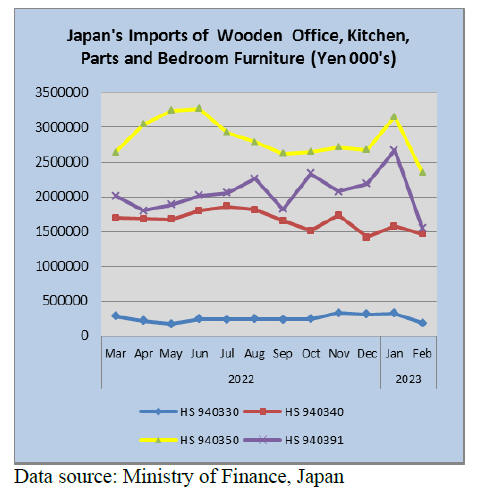
February 2023 wooden office furniture
imports (HS 940330)
The value of Japan’s wooden office furniture (HS940330) imports in
February was down 11% year on year and by 43% compared to Janauary this
year. The biggest losers were shippers in China who saw their share of
imports of HS 940330 drop from the over 90% in Janauary to 77% in February.
In February the other major suppliers were Indonesia and Poland.
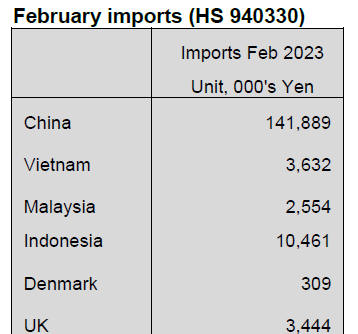 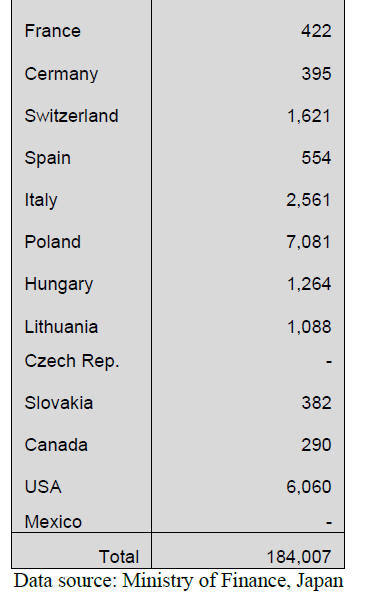
February 2023 kitchen furniture imports (HS
940340)
As was the case in January, over 70% of the total value of wooden
kitchen furniture (HS940340) imported by Japan in February this year was
from just two sources, the Philippines (43%) and Vietnam (23%).
Shipments of HS940340 from Vietnam in February were over 20% below that in
January. On the other hand there was an increase in the value of shipments
from Italy, Thailand and Germany.
Year on year Japan’s the value of imports of wooden kitchen furniture was
down 6% while compared oe January there was a 7% decline.
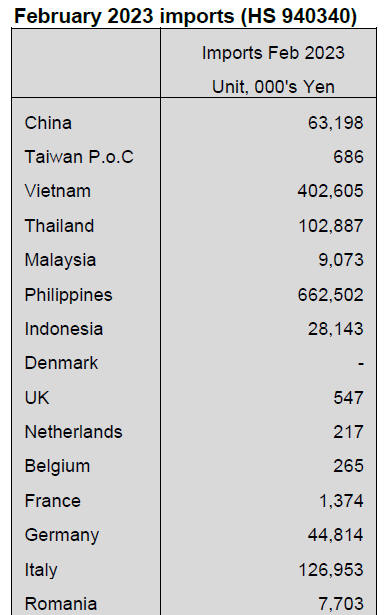 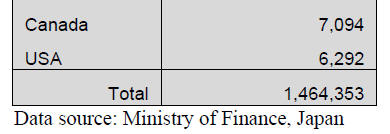
February 2023 wooden bedroom furniture
imports (HS 940350)
After the surge in the value of January imports of wooden bedroom
furniture there was a massive downward correction in February. It is likely
that this decline was due to the impact on trade of the New Year
celebrations in both China and Vietnam.
The value of arrivals of HS940350 from China in February was down 11% while
compared to Janaury there was a 25% decline. Shipments from China were down
40% in February while shipments from Vietnam dropped 15% in February.
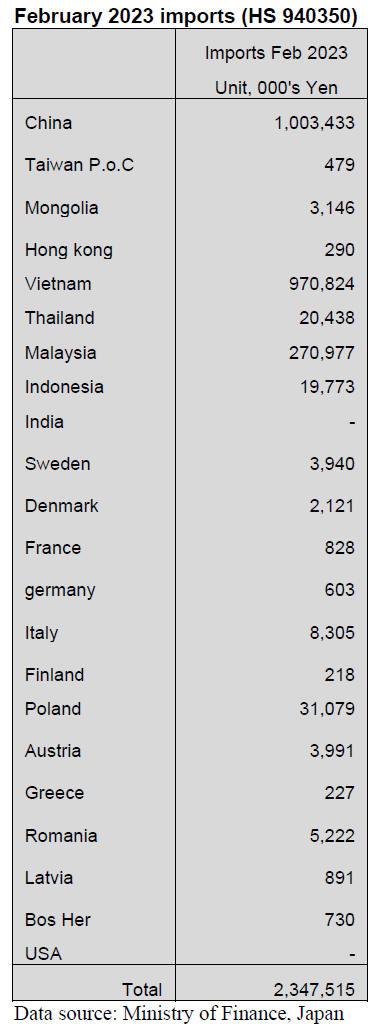
February 2023 wooden furniture parts imports
(HS 940391)
The impact of factory closures in China and Vietnam around the time
of the New Year is evident in the steep decline in the value of wooden
furniture parts (HS940391). Shipments from China and Vietnam were down by
half in February compared to a month earlier.
The top suppliers in February were China, Indonesia, Malaysia and Vietnam
and the value of shipments from each was down from a month earlier except
Indonsia for which the value of imports was little changed from Janauary.
Year on year the value of Japan’s imports of wooden furniture parts dropped
12% while month on month there was an over 40% decline.
 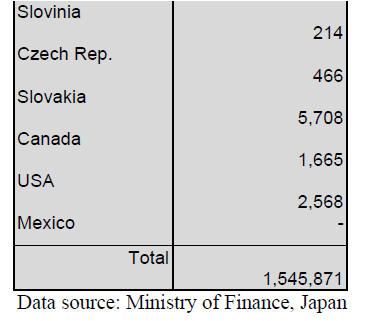
Trade news from the Japan Lumber Reports (JLR)
The Japan Lumber Reports (JLR), a subscription trade journal published every
two weeks in English, is generously allowing the ITTO Tropical Timber Market
Report to reproduce news on the Japanese market precisely as it appears in
the JLR.
For the JLR report please see:
https://jfpj.jp/japan_lumber_reports/
JAS certification on fixture materials of LVL
Woodsland Joint Stock Company in Hanoi, Vietnam got the
certification of JAS (Japanese Agricultural Standards) on LVL fixture
materials on 28th, February in this year. Styrax and acacia are used to
produce LVL and production is 2,000 – 3,000 cbms in a month. Sojitz Building
Materials Corporation will be in charge of finding a market for studs for
apartment buildings, cradling, core materials for fittings and materials for
prefabricated houses. About 2,000 – 2,500 cbms will be supplied in a month.
The company got the JAS certification for its first plant. The first plant
has the ability of producing over 2.7 meters of LVL for 2,000 cbms and under
2.7 meters of LVL for 3,000 cbms. The company used to produce acacia
building materials to Australia but the company started to look for a new
market due to intensification of competition in Australia. There are about
30,000 hectares of an afforestation area owned by the company.
About 6,000 hectares of the afforestation area has the FM (Forest
Management) of FSC (Forest Stewardship Council) for acacia. This
certificated acacia will be supplied to Japan. However, it would take time
to expand the use of acacia in Japan because many Japanese prefer white
colored LVL without burls such as styrax. Therefore, the company will expand
styrax LVL in Japan at first, then the company will see how the styrax LVL
move in Japan and propose acacia LVL.
Use more domestic lumber for 2 x 4 construction
Daito Trust Construction Co., Ltd. in Tokyo Prefecture finished
testing the strength of domestic red pine lumber for 2 x 4 construction and
confirmed that the strength is enough to use.
The company had been working with Forest Research and Management
Organisation and several other cooperative business associations to build
100% domestic lumber structures by 2 x 4 construction since 2022.
Japanese red pine from Iwate prefecture was used for testing the bending
strength and tensions. Results of tests and analyses, Japanese red pine
lumber is strong enough to use as floor joists and taruki of 2 x 4
construction. The company also designed a structure by using Japanese red
pine lumber as testing. For example, domestic cedar lumber for floor joists
on the 1st floor and Japanese red pine lumber for floor joists or taruki on
the 2nd floor. Moreover, domestic cedar lumber and Japanese red pine lumber
are for ceiling joists.
Purposes of the company are to curb climate change, to make forestry and
wood industry more active in Japan, to supply domestic lumber stably and to
promote using more domestic lumber. The company has been working on using
domestic lumber since 2009. Now, the company procures cedar mainly from
Kumamoto Prefecture, Iwate Prefecture and Kagoshima Prefecture.
UPM withdrew from Russia
UPM sold all its operations in Russia, including Chudovo plywood
mill, to Gungnir Wood Products Trading and completed withdrawal of its
business from Russia. Details of transaction are not open to the public.
South Sea logs and lumber
South Sea logs have been exported from Sabah, Malaysia to Japan for
the first time in five years. Actually, a banned export of logs was lifted a
year ago and logs had been exported to China until this year. Demand in
Japan remains strong at shipbuilding companies and steelmakers and there are
a lot of inquiries from South Sea lumber companies in Western Japan. Demand
seems good so far but it depends on the economy because prices are up in the
world.
The price movement of South Sea lumber and Chinese lumber in overseas and
Japan are having a temporary lull. Shippers in Indonesia would not lower the
prices because they were fasting for Ramadan at the end of March and they
had an Islamic New Year’s holiday at the end of April so the product will be
reduced.
A new platform for the J-credit Scheme
Sumitomo Forestry Co., Ltd. and NTT Communications Corporation work
together for creating a new platform for the J-credit scheme and start the
new platform in April. The J-credit Scheme is designed to certify the amount
of greenhouse gas emission reduced and removed by sinks within Japan. Under
the J-Credit Scheme, the government certifies the amount of greenhouse gas
emissions, such as CO2, reduced or removed by sinks through efforts to
introduce energy-saving devices and manage forests, as ‘credit’.
Credits created under the scheme can be used for
various purposes, such as achieving the targets of Japan Federation of
Economic Organizations to a Low Carbon Society, and carbon offset.
Those two companies start with PoC (Proof of Concept) for credit suppliers
and credit users. The new cloud service platform provides information about
forest resources or location of forest to the credit suppliers such as
owners of forest or examining authorities and the credit users by using GIS
(Geographic Information System). The services are:
Managing information of forest business, afforesting, or reforestation
with maps or pictures.
To support forest owners or forestry organizations to create the credit.
To support creating documents for applying certifications of the credit.
To provide any information about the credit for the credit suppliers and
the credit users for their transparency business.
Able to search good credit suppliers.
|